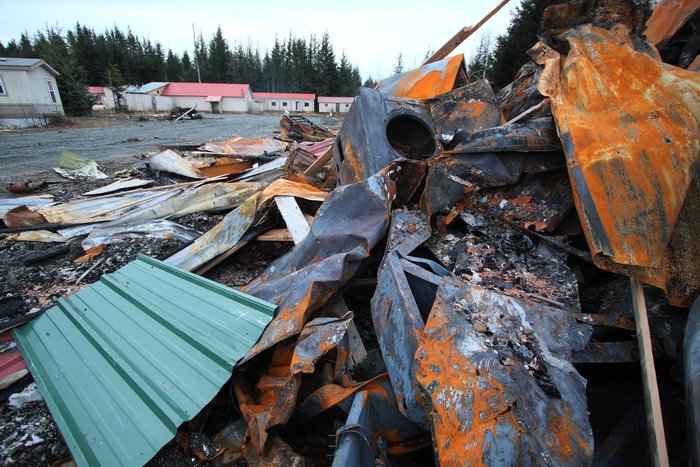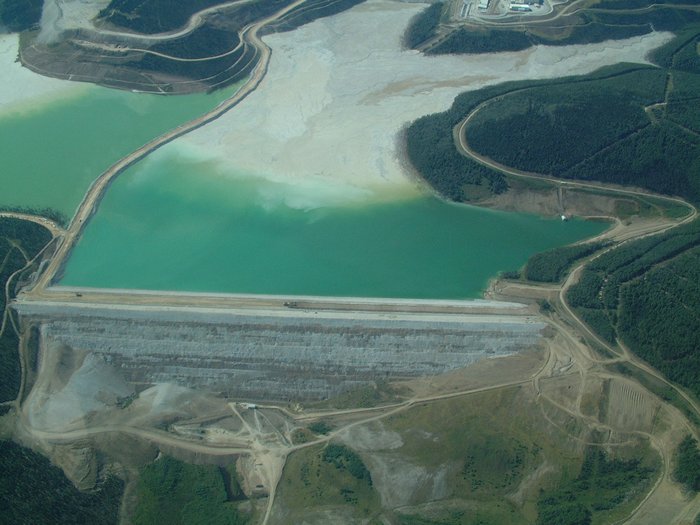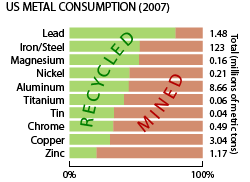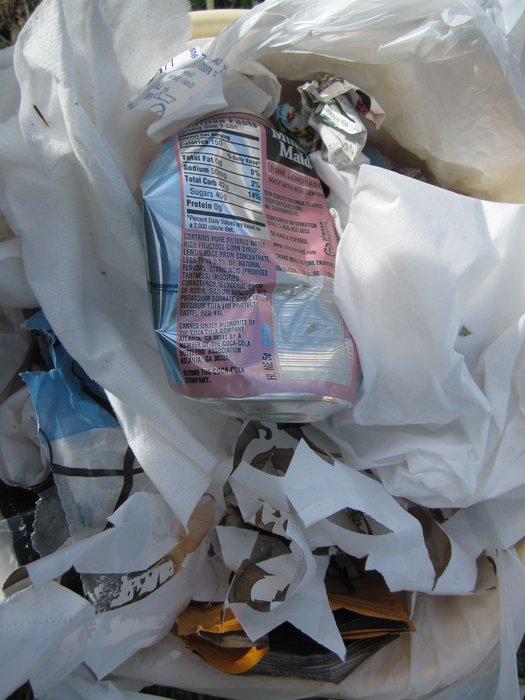
- An essay by David Coil
- Summary
- Introduction
- Reduce, Reuse, Recycle
- Recycling Metal
- Aluminum Example
- So what’s our problem?
- Conclusions
An essay by David Coil

Summary
Recycle, Recycle, Recycle! The simple solution to all our environmental woes, or a feel-good waste of time and money? Delving into the impacts of metal mining, we can easily come up with problem after problem. But what about the other side? The simplest rebuttal to anti-mining is “we need metal, therefore we need mines… so stuff it.”
But it’s not so simple. The continual creation of new mines is polluting in the short term, and unsustainable in the long term. There are two different, and complementary, solutions to the environmental (and ultimately economic) problems associated with metals mining. The first is improved regulation and oversight of existing and future mines, and the second is for society to reduce demand for metals in the first place, through a combination of recycling and smarter product design
Metal recycling is an important way of reducing the environmental impact of metal extraction, and is a necessary part of a sustainable economy. Under current economic conditions, many metals are more economical to extract from the earth than to recycle, partly because the price of these metals doesn’t take into account all hidden costs.
Introduction

Metals mining and ore processing directly impact the environment through deforestation, habitat destruction, and pollution. Common problems include acid mine drainage and the use of toxic chemicals, such as cyanide. The supply chain, from ore in the ground to finished product, also usually requires large amounts of energy and produces significant greenhouse gas emissions. These negative impacts affect ecosystems, human health, and the economy. However, these costs of mining are often not included in the market price of metals, and therefore the “true cost” of metal extraction is actually much higher than it appears. Metals are a finite resource, and whether or not we care about the impact of mining, extraction cannot continue indefinitely.
However, metals are nearly ubiquitous in day to day life, and an important component of all sorts of products. Mining and mineral processing enrich those who control the sources of mineral wealth. How can we minimize negative consequences without going back to the Stone Age?
Reduce, Reuse, Recycle
Reducing the amount of metal required by society, re-using metal objects, and recycling all lower demand for metal ore. “Reduce, Reuse, Recycle” is a waste hierarchy; its elements are listed in order of decreasing impact on new demand. Directly reducing demand is the most efficient and has no environmental impacts, re-using has a similar effect, and recycling is the least efficient of the three methods to lower demand.
However, recycling is arguably one of the easiest for people to control, and can be undertaken with fewer changes in lifestyle. All of the components of the waste hierarchy are, ultimately necessary for societies to use natural resources sustainably.
Recycling Metal

Metal is one of our more easily recyclable substances. Melted down metal from a discarded piece of junk is chemically identical to newly-refined metal from a mine. Even though it is possible to recycle the majority of the metal we use, only about half of the base metal supply came from recycled sources in 2007, the most recent year surveyed. This “recycling rate” varies with the type of metal, ranging from a recycling rate of only 20% for zinc to a rate of almost 80% for lead, depending on the price of the metal, the cost of mining for that metal, what forms the metal is found in, the energy requirements of processing, and more. The case of aluminum is a good example of the positive and negative economic and sociological forces affecting recycling rates.
Aluminum Example
Even in the case of aluminum, for which there are clear economic and environmental benefits to recycling, the recycling rate is only around 50% due to a combination of sociological, and logistical factors.
_
“When you toss out one aluminum can you waste as much energy as if you filled the same can half full with gasoline, and just threw it on the ground”
_
__
Aluminum is a common metal with a relatively low value ($2000/metric ton in July 2010). However, it takes a surprising amount of energy to produce a single aluminum beverage can: enough to power a television for three hours. Because of the large energy requirement for ore processing, most aluminum smelters are found near cheap and/or heavily subsidized sources of power, such as hydroelectric plants in Scandinavia. In addition to the large energy and direct water usages associated with the production of aluminum, there are significant problems with mining pollution (primarily air emissions and solid waste), transport pollution, and environmental impacts of massive hydroelectric projects. A potent reminder of these problems appeared in Hungary in October 2010, when a massive toxic spill from an aluminum smelter killed 10 people, injured dozens more, and contaminated multiple waterways.
The vast majority of the energy is required in the early stages of metal production, making aluminum a prime candidate for recycling. To produce a new beverage can from recycled aluminum only requires 5% of the energy, 3% of the water, and emits 5% of the greenhouse gas emissions relative to a can produced from newly mined ore. In addition, 100% of the aluminum from discarded cans and other objects can theoretically be recycled since none of the metal is lost in the process. It’s relatively simple to recycle since it simply needs to be melted down and then formed into new shapes. Because aluminum is so profitable to recycle, it often ends up subsidizing other recycling and pickup programs.
Despite all of these positive factors, a large amount of aluminum is discarded every year… around 50% of the total. Only about half of the 131 billion easily-processed aluminum cans created each year in the US are recycled. Even lower post-consumer recycling percentages are found in industries such as construction and car manufacture. Only 45% of the aluminum supply in 2007 came from recycled sources, leaving almost 5 million metric tons of new aluminum to be mined to fill the demand, with the associated environmental impacts. Not only is this problematic from an environmental perspective, but the market value of scrap from wasted aluminum cans alone in the year 2000 was $800 million! So much aluminum is found in landfills that the concentration is actually higher than in the starting ore, and some people argue we should be mining the landfills themselves.
So what’s our problem?
The economic and environmental case for recycling aluminum is clear cut. It saves energy, money, and the environment. Yet the rate of aluminum recycling is disappointing low, most likely due to a combination of sociological and logistical factors.

__
Sociological factors
There are numerous reasons that people chose to not recycle that are not related to the economic or environmental aspects of recycling. Convenience is commonly cited. Other reasons include a backlash against sanctimonious pro-recycling programs/people, the belief that recycling is uneconomic, the belief that there is insufficient demand for recyclables, and the attitude that one person’s lack of recycling doesn’t make a difference. Education could convince some of the non-recyclers. If people were aware that recycling aluminum is very economical, and that there is a large demand for recycled aluminum (and most other recyclables actually) some would be willing to change their mind and habits. Sanctimony (of people who recycle) and apathy (of people who don’t) are more difficult to address. Financial incentives can help with apathy… numerous people collect and recycle aluminum cans for the deposit alone. Convenience can be addressed to some extent through improved logistics, such as curb-side recycling programs.
Logistical factors
Many people understand the importance of recycling, but are put off by the inconvenience. Most cities do not have a curbside recycling program, which means that people need to store and transport aluminum themselves if they want to recycle. Likewise, many cities lack public recycling receptacles, leaving people in public places with no option other than putting everything in the garbage. Finally, not all aluminum ends up in cities. In far-flung locations, small volumes and high shipping costs make recycling impractical.
Conclusions
Metals are an integral part of modern society, but their extraction is often environmentally destructive and entails many hidden costs. As long as demand for metals remains high, there will always be new mining operations. Reducing demand through recycling is one way that everyone can impact this process. Aluminum is probably the most well-known and easiest metal to recycle… yet more aluminum is wasted every year through carelessly discarded cans than is used to produce new trucks, buses, bridges, and roads combined. Fixing this problem will require a change in the values of consumers and the will of society to make recycling a simple and expected part of daily life.
However, the issue of sustainability cuts much deeper than recycling aluminum cans. Because metals are a finite resource that is extracted at a high price to the environment, any reduction in demand is important. For example, another important part of this picture is product design and product durability. Products containing metal are often designed to be thrown away, and are rarely designed with recycling as a priority. A system that required manufacturers to taken back products at the end of their life cycle would address some of the hidden costs, as well as presumably dramatically influence product design.
Further Reading
Created: Jan. 19, 2018